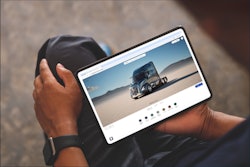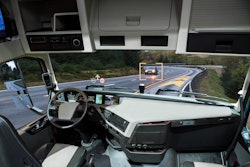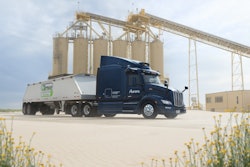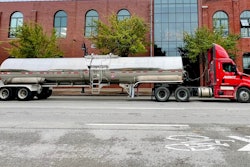New in-cab devices and options open a world of possibilities for improving driver productivity.
In May, Dorothy Vankoughnett saw a demonstration of a technology for scanning documents from a truck cab. Soon afterward, she convinced drivers and executives at Berry & Smith Trucking about the benefits.
“I’ve been mentioning it to drivers since spring,” says Vankoughnett, controller and information technology manager for the Penticton, British Columbia-based carrier. “I’ve now got a lineup of drivers wanting to use it.”
In September, PeopleNet – the fleet’s onboard computing and communications provider – announced a new feature, In-Cab Scanning, through a partnership with Microdea, a provider of document imaging and workflow management software. Berry & Smith began to implement the new technology last month in its 125 trucks. In-Cab Scanning, Vankoughnett says, is “another good way to attract drivers.”
Berry & Smith drivers now can save valuable time by transmitting documents from their trucks, such as time sheets, signed proof-of-delivery papers, U.S. Customs forms and chassis inspections for intermodal containers. Documents can be immediately indexed and matched with trip and billing records in the company’s TruckMate enterprise management system by TMW Systems.
There is even competition in the in-cab scanning market. ACS TripPak last month announced an arrangement with DriverTech to provide the capability. Scanned documents would integrate with other TripPak services.
The latest in-cab computers are much more flexible and powerful than past models. Combined with new options for low-cost high-speed wireless connectivity, fleets are beginning to explore new ways to improve driver productivity and satisfaction. Possibilities include using new and improved applications to reduce guesswork, simplify data entry and workflow, and help drivers better manage their jobs – and their lives.
Eliminating uncertainty
One of the most popular applications for drivers is navigation. All of the leading providers of onboard computing systems now offer – or soon will offer – options for using in-cab navigation on color touchscreen displays. When integrated with dispatch, these systems give drivers spoken directions from origin to destination.
“Something drivers are looking forward to is the turn-by-turn directions and mapping displayed on the dash-mounted unit,” says Chuck Hollis, manager of information systems for Dedicated Logistics. In August, the company installed the GeoLogic system with the optional Color Display Unit in its 42 trucks. The Crossett, Ark.-based company is ready to offer street-level mapping and turn-by-turn spoken directions when they become available, Hollis says. Susan Fall, a spokesperson for GeoLogic, says navigation will be available in the next few months.
Starting last year, U.S. Xpress Enterprises began using in-cab navigation and real-time information to cut costs and improve driver satisfaction, says Ken Crane, the company’s application manager of mobile technology. Management at U.S. Xpress saw that bad data in its dispatch applications – directions, in particular – were causing drivers to waste time searching for customers and fuel stops. The Chattanooga, Tenn.-based truckload giant had relied on its drivers to report directions, which it stored in a database.
“We found that drivers are notorious for providing bad directions,” Crane says. “We found situations where they like to play games. That has always been a concern, but of late it had become more of a concern.”
In 2006, U.S. Xpress began to deploy the DriverTech TruckPC onboard computing platform with ALK’s CoPilot turn-by-turn navigation software. The company also worked with fuel optimization vendor IDSC to incorporate optimal routes and fuel information into CoPilot.
“Once you start adopting this technology, you are going to find the holes in your operations pretty quickly,” Crane said during a presentation at the ALK 2007 Technology Summit held last April. Besides operational cost savings, the company has seen retention benefits, as drivers say they like having a navigation system in their vehicles. It also has helped drivers increase their fuel compliance.
“We have had drivers that have pressed us for the new technology,” Crane says. “We have quite a few that don’t think they can work without it.”
Advanced in-cab mapping and navigation tools remove a common job frustration for drivers – uncertainty. Drivers also enjoy having more say with their time and finances. For this reason, some fleets use applications that appeal to drivers’ sense of control and independence in determining their schedule and pay.
New Line Transport – a Jacksonville, Fla.-based carrier that hauls building materials throughout the Southeast – offers its drivers, nearly all of whom are owner-operators, a choice of loads in the cab by using the McLeod LoadMaster enterprise system and OmniExpress system from Qualcomm.
In the office, dispatchers select four loads to send to each driver, usually a day ahead. Each load is linked with a secondary load, such as a backhaul. If drivers accept one, they accept both. Whoever responds first through their Qualcomm units to the offering gets the load.
“We try not to offer the same loads to drivers at the same time,” says Bryn Wells, operations and marketing manager for New Line Transport. “If you offer choices, you have to allow some time for them to decide.” Offering drivers a choice of loads in the cab “makes it more like a phone conversation, not ‘here, take this,’ ” he says.
Innovative Computing Corp. (ICC) offers a standard feature in its enterprise software called Load Offer, which allows dispatchers to preplan and send up to three loads to drivers through a mobile communications platform. Marla Grant, ICC’s director of sales, says some customers choose to use Load Offer as an exclusive perk to senior drivers.
Integrating with the home office
Many of the latest technology developments focus on improving the workflow of drivers to make them more efficient, productive and in control of their schedules. Fleets are taking advantage of these newer, more intelligent onboard applications that require more computing power, memory and wireless bandwidth than was available a few years ago.
Plaines All American Marketing, a petroleum hauler with 450 trucks that operates in 19 states, uses the Xatanet wireless fleet management system from Xata Corp. Mickey Masters, dispatch manager for the carrier’s terminal in Midland, Texas, says that one of the advantages of Xatanet’s latest release, Xatanet 4.0, is the system’s ability to interface with nonproprietary devices for flexibility in choosing in-cab displays and peripheral devices.
Plaines All American Marketing, which uses WinCE handheld devices with full keyboard functionality, also has printers in trucks. Drivers like the flexibility of Xatanet for automating their logbooks and the “ticketing” process when picking up crude oil from pumping stations in the field, Masters says.
Drivers are dispatched on routes with preprogrammed virtual geofences stored in the handheld devices. When drivers pull up to within 100 feet of an assigned location, the device automatically pops up a ticket for the driver. Once the driver approves the ticket, he prints a receipt to hand to the pump operator. The ticketing process is closed automatically when the driver leaves the geofence. The company also is looking to add navigation to its WinCE devices to further improve the workflow process for drivers, Masters says.
Today’s mobile computers can store much more data than previous models. In addition, mobile devices have virtually the same operating systems and database functionality as PCs and servers in the office. This functionality makes it possible to replicate a large portion of the database a fleet uses in its back-office environment – such as information on routes, locations and customers – onto mobile devices, says Dave Mook, chief technology officer and chief operations officer for enterprise software provider TMW Systems.
Furthermore, several vendors that offer onboard computing and fleet management applications have “opened up” their platform to allow fleets and third parties to add custom applications. Together, these developments have moved mobile computing from being “message-centric” to more of a data replication model, Mook says.
A data replication model means that instead of drivers and fleets sending text messages back and forth for directions, phone numbers, work assignments, etc., drivers can query a mobile device directly. A mini-database, replicated from the database in the office, is loaded onto the device and updated through wireless communications.
The data replication model also enables instant data validation as drivers input their hours, load weights, piece counts, trailer numbers, etc. And fleets can provide drivers with instant access to driver-related information such as year-to-date earnings, the status of a toll reimbursement, etc.
Pursuing the trend toward data replication, TMW Systems is expanding its D2Link platform-independent software product for wireless devices. The company also has developed OnRoute, a D2Link application, in collaboration with Qualcomm for Sprint PCS phones and mobile devices.
Workplace safety
Another trend that continues to make in-cab technology more appealing to drivers and fleets is the integration of various safety data and electronics to a central display unit. Integration helps reduce cab clutter as well as improve data collection and presentation from devices such as cameras, collision warning systems, tire pressure monitors and lane departure warning systems.
In May, Richard Olsen, chief executive officer of Fil-Mor Express, spoke before the U.S. Senate Committee on Commerce, Science and Transportation during a hearing on electronic onboard recorders (EOBRs) and truck driver fatigue.
In his remarks, Olsen said his 175-truck company integrated a variety of safety devices into the fleet’s DriverTech TruckPC computer. Fil-Mor Express, based in Cannon Falls, Minn., placed a camera on the passenger-side blindspot; the camera plugs into a video port in its DriverTech in-cab computer. The company also plugged into a separate port on the TruckPC a system that measures the pressure and temperature of tires at each wheel position; warnings are displayed to drivers immediately. Fil-Mor Express also plugged in a seat belt monitoring sensor.
Drivers also record pre-trip inspections and run electronic logs on the same DriverTech display. By integrating all of these separate monitoring systems into one device, Fil-Mor Express benefited by having no out-of-service violations for more than a year, Olsen said.
Other vendors are incorporating safety-related features into their offerings. In August, PeopleNet announced a three-phase integration plan with the Eaton Vorad system that will allow data to be transmitted in real time to back-office software for real-time analysis. And Qualcomm’s new OmniVision platform allows drivers to listen to and replay critical messages, eliminating visual distractions.
The sky’s the limit
In truckload operations where drivers are away from home and the office for extended periods, some fleets are offering PC-based applications for drivers such as Internet access from the cab, and training and distance education.
Instructional Technologies Inc. (ITI) has signed agreements with PeopleNet, DriverTech and GeoLogic to offer its Pro-Tread in-cab safety training. Pro-Tread is a Web-based version of ITI’s software that is hardware-independent. Fleets can assign and track the completion of different training modules to drivers. The modules can be accessed from any Web browser as well as loaded onto the hard drives of onboard computers, says Bruce Weiss, executive vice president of ITI.
Last July, TransMarkets launched In-Cab University as a continuing education and driver retention program. The company joined with an accredited private school, Mountain State University in West Virginia, to offer online bachelor’s and master’s degrees in organizational leadership.
TransMarkets selected the DriverTech TruckPC platform to launch its virtual in-cab classroom. Drivers can login from their cab or through any PC. Several large carriers already have elected to offer In-Cab University degree programs to drivers, including Express-1, Covenant Transport, U.S. Xpress and Smith Transport. The programs are flexible, allowing drivers to transfer college credits and military training, says Craig Fuller, president and CEO of TransMarkets.
Vendors say that a variety of training and information resources for drivers easily can be added to onboard devices where demand exists – such as resources for hazardous materials training and incident management; in-cab printing for permits and other paperwork; and audio/video conferencing.
For starters, the next generation of in-cab computing can eliminate drivers’ need to purchase laptops for personal use. But the real benefit of having virtually the same computing power, functionality and network connectivity available in the cab as in the office is the new world of possibilities for improving driver productivity and job satisfaction.
A boost of power
The latest onboard computers offer breakthrough computing capabilities
In the past year, several providers of onboard computing and mobile communications systems have announced and released their next-generation hardware devices. Common features include color touchscreen displays, a significant boost in computer memory and processing power, and connectivity options to peripheral devices such as scanners and printers through USB and RS-232 ports. These rugged devices have the computing power of a typical PC in an office.
Lacking space to include all vendors, below are a few examples of the latest hardware offerings from vendors that have selected a standard hardware platform going forward. All computers include standard SAE J1708 and 1939 engine data bus ports, but many also have new options for connecting with peripheral devices. Several vendors not included in this list, such as Xata Corp., have developed their software to work with a variety of powerful fixed or mobile computing devices.
The Cadec PowerVue On-Board Computer weighs nearly 2 pounds and features a 7-inch (diagonal) full-color LCD touchscreen with 32 MB flash standard hard-drive memory, and 128 MB RAM upgradeable to 1 GB SD flash. It has a 512 MHz processor and Windows CE operating system. Interfaces include four USB ports, speaker, microphone, four RS-232 serial ports, a compact flash card slot and an SDIO slot.
The DriverTech TruckPC platform has an 8.3-inch (diagonal) LCD color touchscreen that weighs 3.5 pounds. The display connects to an onboard computer with a 40 GB hard drive with 1 GB of RAM. The computer has a 1 GHz processor and runs an embedded Windows XP operating system. Port interfaces include two RS-232s, four USB, three video inputs, an audio outport, Ethernet port, TV/video outport and regulated power outport.
GeoLogic’s Color Display Unit (CDU) has a 6.1-by-3.7-inch screen and weighs 3.4 pounds. Its hard-drive memory is 128 MB or 2 GB of compact flash with 64 MB of SDRAM, which is expandable to 128 MB. It has a 416 MHz processor and runs on a WinCE operating system. It has two USB interfaces.
The PeopleNet BLU Driver Center Display weighs 5 pounds and features a 7-inch (diagonal) LCD color touchscreen with 256 MB standard and up to 8 GB of hard drive memory, a 1.5 GHz processor and either Windows XP or Windows Mobile operating systems. Interfaces include three USB ports, speaker, microphone, Ethernet, a RS-232 serial port, a RS-422 serial port, a compact flash card slot and an RJ45 connector.
Qualcomm’s OmniVision platform has a 7-inch (diagonal) LCD touchscreen in a media unit that weighs 3.5 pounds. The system has 128 MB of flash memory and 128 MB RAM with a secure digital slot for expansion. It has a 400 MHz processor and runs on an embedded WinCE. Port interfaces include three USB, RS-232, one configurable interface for RS-232 or RS-485, and a secure digital port that allows the future addition of large databases.










